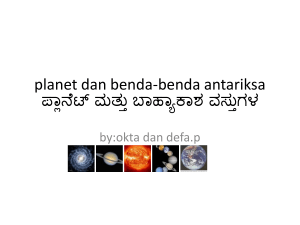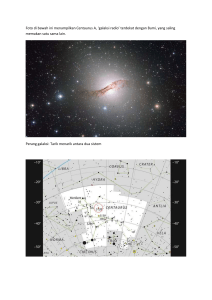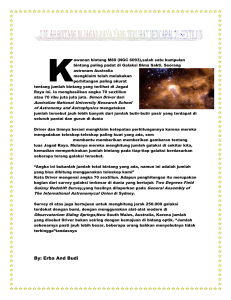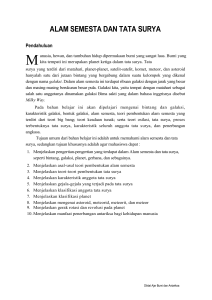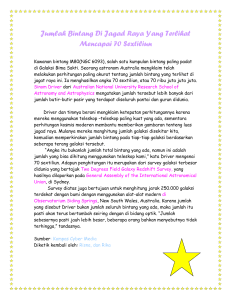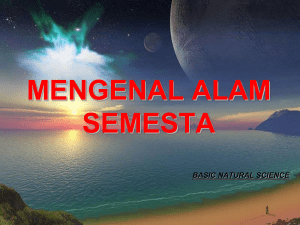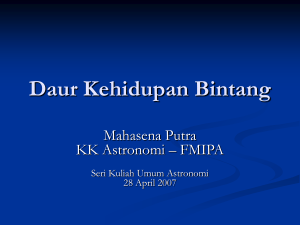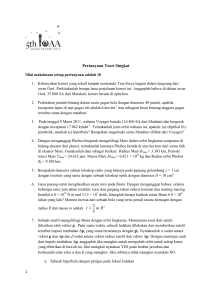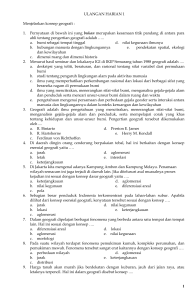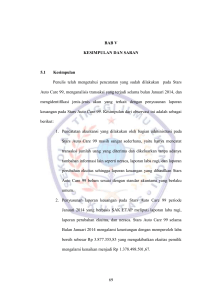Dasar Astronomi - smpawahidhasyim2rejoso
advertisement
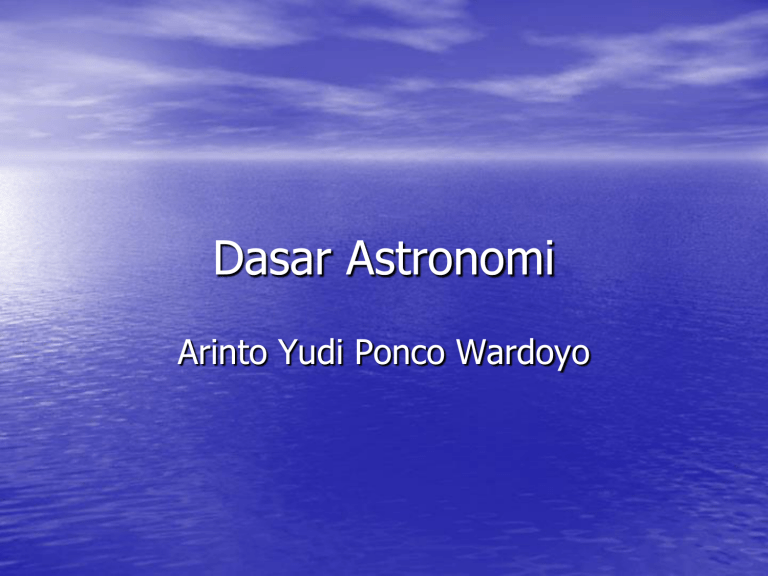
Dasar Astronomi Arinto Yudi Ponco Wardoyo Pendahuluan Sejarah : • Aristoteles (3 BC) : Bumi diam & pusat alam semesta; bulat (bisa lihat bintang saat bergerak keutara selatan, bayangan bumu ke bulan adalah elips). • Ptolomy (2AD) : Bumi pusat solar sistem. • Setelah sekitar 1400 tahun Nicolaus Copernicus menggunakan matematika : matahari pusat tata surya, dan planet dan bintang bergerak. Johannes Kepler : gerakan planet adalah elips. • Setelah penemuan refracting telescope, Galileo Galilei menggunakan untuk mengamati lubang di bulan dan bulannya jupiter. Dia membenarkan bahwa matahari pusat tata surya. • Isaac Newton menemukan reflecting telescope (menggunakan kaca bukan lensa) dan mengusulkan Theory of Gravity (menerangkan bagaimana planet diam pada tempatnya). Sekitar waktu yang sama Gian Cassini mengukur jarak antar planet ( parallax shift method). • Beberapa nama dalam astronomy :Hipparchus, Tycho Brahe, Edmond Halley, William and Caroline Herschel, Edwin Hubble, Henrietta Swan Leavitt, Harlow Shapley, Percival Lowell, Vesta Slipher and Albert Einstein. Pengenalan Jagad Raya • Apa yang kita lihat dengan mata ? – Matahari, bulan, planet, bintang (di dalam galaksi kita), supernova • Apa yang kita lihat dengan teleskop ? – Galaksi lain, pulsar (bintang neutron) • Objek di Jagad Raya ? – Bintang – Pulsar – Black hole Tata Surya Proses terbentuknya Alam Semesta 13 Dec 2007 Galaksi • Matahari adalah salah satu bintang di galaksi kita (Milky Way/ galaksi spiral) terdiri dari 2 x 1011 bintang (dengan teleskop). • Beberapa galaksi (contoh : Andromeda) dapat dilihat dengan mata. Galaksi dg teleskup Humble • Pemandangan di • • langit ( tidak ada bintang yang dapat dilihat dengan mata). “Red shift galaxies” bergeser menjauh. Galaksi tsb adalah berumur yang paling tua. Terbentuknya Bintang & Galaksi • Galaksi terbentuk dari awan gas (sebagian besar • hidrogen) yang terikat oleh gaya grafitasi. Bintang terbentuk dari kondensasi gas didalam galaski karena gaya grafitasi. – Mulai dari “membakar” bahan bakar nuklir pada keadaan sangat padat (dense) and panas sehingga terjadi reaksi fusi dan melepaskan energi. – Matahari berbahan bakar hidrogen (proton) dan deuterium (proton + neutron) membentuk helium. – Elemen yang lain terbentuk pada bintang yang lebih besar, dan elemen berat terbentuk pada Supernova. Lahirnya Bintang Lahirnya bintang dari awan gas hidrogen dilihat dengan teleskup Humble Akhir dari Bintang • Apa yang terjadi bila bahan bakar nuklir habis ? – Bintang habis (collapse) krn gaya grafitasi • Bagaimana pengaruh massa ? – Bintang sangat kecil (< matahari) menjadi “brown dwarfs” seperti jupiter. – Bintang kecil (=matahari) menjadi “white dwarfs” dg seukuran dengan bumi. – Bintang besar pecah menjadi bintang neutron atau black hole. • Meledak menjadi supernova dengan energy yang besar. • Massa > 1.3 massa matahari menjadi bintang neutron (pulsar). • Massa > 1.5. massa matahari menjadi black hole (dengan kekuatan medan gravitasi yang sangat besar shg tidak ada massa yang terlepas). Sisa Bintang yang meledak Kumpulan awan gas dipancarkan dr pusat bintang (< matahari). Dari kondisi panas menjadi dingin akibatnya terbentuk White dwarfs. Supernova • Semua benda berat in jagat raya terbentuk di dalam supernova (bintang mati). • Hasilnya pulsar dan black hole. • Beberapa supernova yang terkenal – 0 : bintang natal – 1054 : di dalam crab nebula (dicatat di China) – 1572 : ditemukan oleh Kepler – Pulsar merupakan sisa dari supernova 1054 & 1572 Istilah Astronomy • Asterism • • • • • • • – A named group of stars that is part of a constellation, the Big Dipper is one. Asteroid – Small, rocky world. Most asteroids are between the orbits of Mars and Jupiter. Astronomical Unit – The average distance between Earth and the sun, 1.5 x 108 km. Aurora – The glowing light from solar particles interact with Earth's magnetic field. Celestial Equator – The imaginary line around the sky directly above the Earth's equator. Celestial Pole – Points above the Earth's north and south poles. Celestial Sphere – An imaginary sphere surrounding the Earth where the sun, planets and stars are, a 3 dimensional map of the universe. Comet – One of the small, icy bodies that orbit the sun that make tails of gas and dust when they get close to the sun. • Constellation • • • • • • • • – A pattern of stars usually named after animals or people in stories. Ecliptic – The path the sun seems to follow in the sky. Emission Nebula – A cloud of glowing gas. Globular Star Cluster – A group of stars that look like a shape of a ball. Light Pollution – Wasted light from city and outdoor lights that makes it hard to see the stars at night. Light-year – The distance light travels in a year. Meteor – Small rocks or sand making a bright trail through the sky as it burns in the atmosphere. Meteorite – A meteor that has landed on the Earth. Nebulae – A glowing clouds of gas or dust reflecting the light of nearby stars. • Open Star Cluster • • • • • • • • • – A group of stars that look close together in the sky. Orbit – The path an object takes as it moves around another object. Planetary Nebula – An expanding ring of gas around a star. Reflecting Telescope – A telescope that uses a mirror to focus light. Reflection Nebula – Dust and gas reflecting light from stars close by. Refracting Telescope – A telescope that uses a lens to focus light by bending it. Rotation – An object spinning about its center. SETI – The Search for Extra-Terrestrial Intelligence. Solar Eclipse – The name of the event when the moon comes between the sun and Earth. Zenith – The point in the sky directly overhead.
